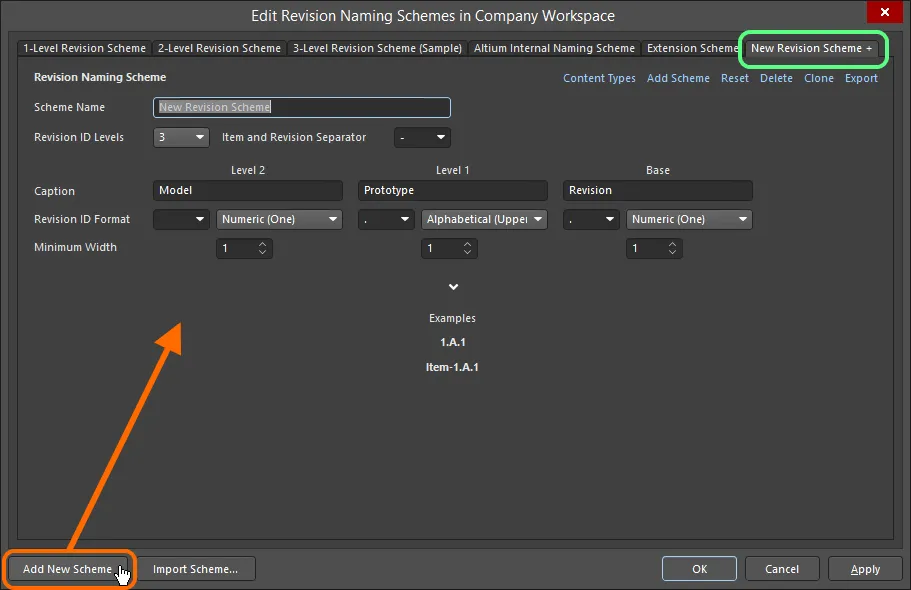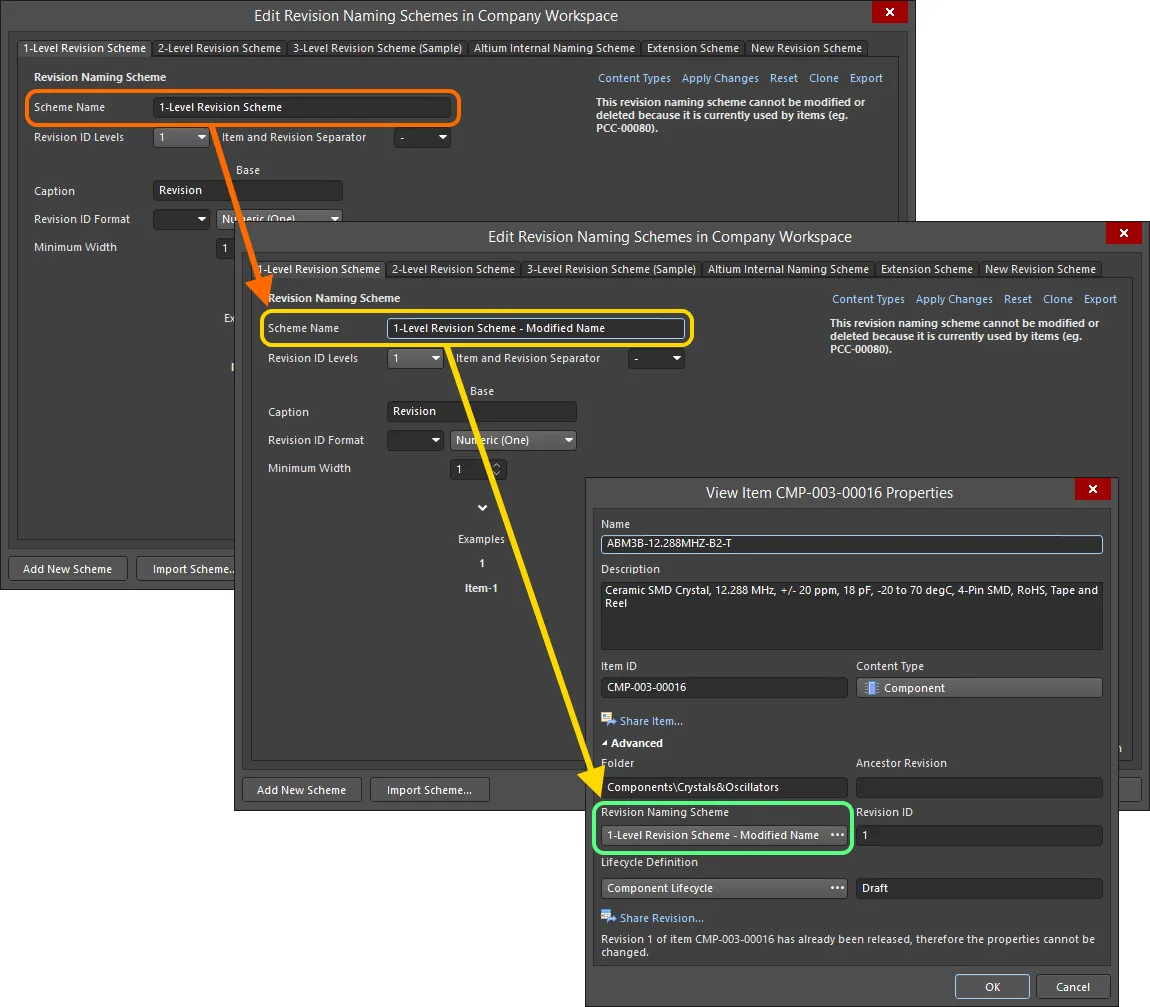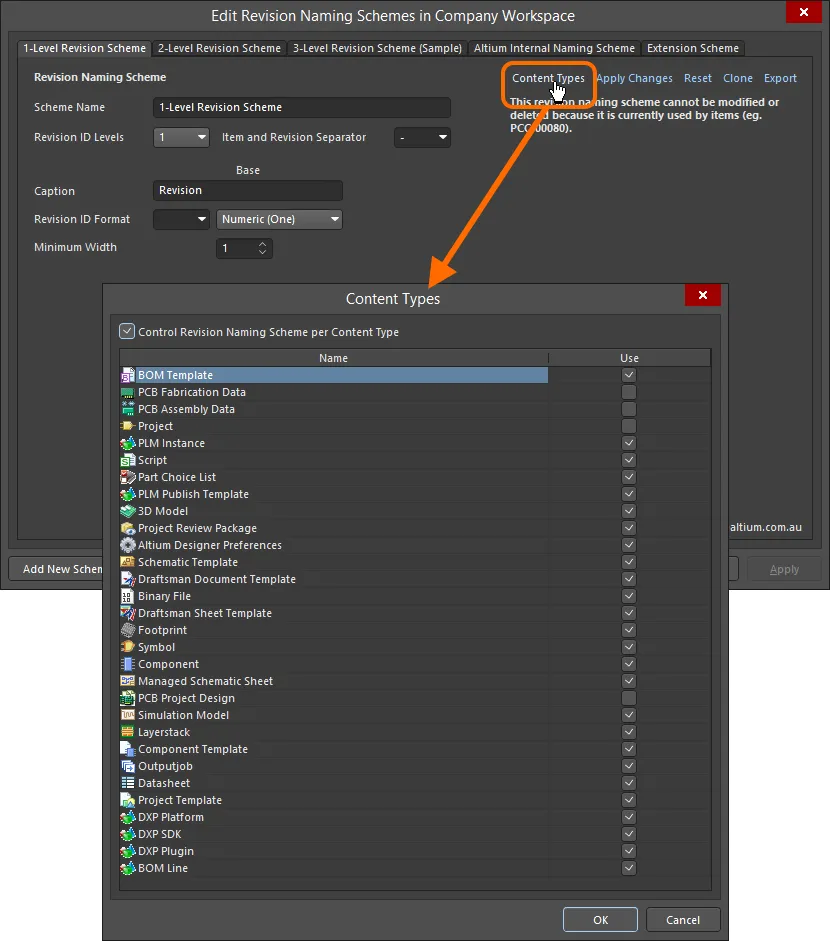Parent page: Server Items
Each Item in a managed content server is comprised of a series of revisions, with a new revision used to accommodate new data, each time that data is modified and committed/uploaded/released. The revision therefore reflects the progress of the Item as it undergoes changes. Or to say that the other way around, if the data entity represented by the Item changes, the revision must be incremented to reflect that.
Each revision has its own unique identifier (Revision ID), that is separate and distinct to that of the parent Item (Item ID). The format of a revision's ID is determined by the Revision Naming Scheme employed for the parent Item. The specific format used in a scheme is configurable and will depend on the needs of each organization.
With both Item and Revision IDs, a combined unique identifier is gained that is used to fully qualify each release of an Item - often referred to as the full Item-Revision ID.
Revision Naming Terminology
The following default terms are used in relation to revision naming schemes. These terms are used to bring meaning and identity to different versions of the same Item.
- Revision - a revision is a new version of an Item. Using a sequential identification scheme makes it possible to see the history of Item versions. The revision section of the Revision ID must be incremented each time the design of the Item changes, when that change is not significant enough to require a new prototype or new model.
- Prototype - a prototype is a working model of a new Item, or new version of an existing Item, that is not yet ready to go to customers. The prototype section of the Revision ID must be incremented each time a new prototype is created for a given model.
- Model - a model is defined as a style or design of an item. Having a Model identifier is useful when there is more than one model, for example 'having the previous model of that tablet'. The model section of the Revision ID must be incremented each time a new model is created.
Default Revision Naming Schemes
A managed content server provides five default revision naming schemes. These default schemes can be used 'as is', or modified to suit company (or personal) requirements. New, custom schemes can also be added and configured, as required.
The default revision naming schemes are as follows:
- 1-Level Revision Scheme - provides a single level of revision naming, in the range 1 to 9, or A to Z, of any width required. Because there is only 1 level of labeling, the Revision ID can only identify the Revision.
- 2-Level Revision Scheme - provides two levels of revision naming, with a default form of Alpha.Number. Examples include A.1, or CZ.83. The first section, or Level 1 of the Revision ID, is used to label the Model. The second section, or Base of the Revision ID, is used to label the Revision.
- 3-Level Revision Scheme (Sample) - provides three levels of revision naming, of the form Number.Alpha.Number. An example would be 02.B.1. The first section, or Level 2 of the Revision ID, is used to label the Model. The second section, or Level 1 of the Revision ID, is used to label the Prototype. The third section, or Base of the Revision ID, is used to label the Revision.
- Altium Internal Naming Scheme - essentially a copy of the 1-Level Revision Scheme.
- Extension Scheme - essentially a copy of the 1-Level Revision Scheme, used for extension data types.
The revision naming scheme applied is chosen at the individual Item level, when creating an Item. Different Items can therefore have different revision naming schemes assigned to them.
Once a defined revision naming scheme is in use by an Item in the server, that scheme can no longer be edited (with the exception of the Scheme Name, which can be renamed), nor can it be deleted. Conversely, once an Item is created and an initial release into a planned revision of that Item is made, that Item can not have its revision naming scheme changed.
Choosing a Revision Naming Scheme
So just how do you choose the right revision naming scheme for your organization? From the previous descriptions it seems that you choose between the simplicity of a 1-level naming scheme, where the revision number simply reflects the current revision of the Item, through to choosing a complex naming scheme that reflects the model, the prototype and the revision. There is no simple answer to this question, it is a matter of considering which scheme best suits your organization’s requirements.
Ideally you will choose a single scheme that can be used across all the Items created in the managed content server for your organization. As for the number of levels, consider the typical life of the products. Do they have a long life and undergo numerous updates? Do you need to be able to easily identity an Item in the field, for example would being able to easily tell the model be beneficial for a service technician? Both of these types of requirements are better served by a 3-level naming scheme.
Larger organizations will typically have their own revision numbering scheme in place already, in that case you can create your own Revision Naming Scheme(s) to match.
Managing Revision Naming Schemes
Revision naming schemes can be viewed and managed from within the Edit Revision Naming Schemes dialog. To access this dialog for the Active Server to which you are currently signed in:
- Open the Data Management - Servers page of the Preferences dialog.
- Click the Properties control, at the far right of the Active Server's entry.
- Choose the Naming schemes command from the associated menu.
 Revision Naming Schemes are defined and managed in the Edit Revision Naming Schemes dialog.
Revision Naming Schemes are defined and managed in the Edit Revision Naming Schemes dialog.
Adding a New Scheme
To create a new Revision Naming Scheme, click the  button at the bottom of the Edit Revision Naming Schemes dialog. A new tab will appear in the dialog, ready to be configured.
button at the bottom of the Edit Revision Naming Schemes dialog. A new tab will appear in the dialog, ready to be configured.

Create your own, custom revision naming scheme.
A newly-added revision naming scheme is distinguished by a '+' suffix in its tab. This reflects that the scheme is still being configured and has not yet been 'saved' to the set of revision naming schemes available to the server.
Configuring a Scheme
Use the controls available within a revision naming scheme's tab to configure that scheme as required.
With the exception of the Scheme Name, which can be renamed, a revision naming scheme that is currently being used by an Item in the server cannot be modified with respect to its configuration.
The following properties need to be defined for a scheme:
- Scheme Name - give this a meaningful name, for example reflective of what server Items the scheme is to be used for.
- Revision ID Levels - choose how many levels should comprise the Revision ID, either 1, 2 or 3.
- Item and Revision Separator - choose the separator used between Item ID and Revision ID, when the full Item-Revision is displayed.
- Caption - enter caption text to reflect the meaning of each level in the ID. Caption text is used in an Item's lifecycle view (for Level 1 and Level 2, not the Base) and also for the right-click menu commands associated to revision-type changes.
- Revision ID Format - specify the format of each level in the Revision ID, as well as a separator prefix for each. Formats supported are: Numeric (Zero), Numeric (One), Alphabetical (Uppercase), Alphabetical (Lowercase), and ASME Y14.35M.
- Minimum Width - define the width of each level in the ID, how many digits/characters are used to represent that part of the ID.
For separator-type fields, the supported separator characters are: '.' (period), '-' (hyphen), ',' (comma), '_' (underscore), and no separator (the blank entry).
As the scheme itself is modified, a dynamic preview of the resulting Revision ID and full Item-Revision ID is presented in the lower region of the tab.

A preview of the resulting ID is presented in the tab, which updates dynamically as changes are made.
Saving a Scheme
Whether a new revision naming scheme has been added, or an existing revision naming scheme has been modified in some way, that scheme must be saved. Although there is no actual 'save' control, there are controls available to perform this:
- For a new revision naming scheme - distinguished by a '+' suffix - either use the Add Scheme control (at the top-right of the scheme's tab), or click the dialog's main
 button.
button.
- For an existing revision naming scheme that has been modified - distinguished by a '*' suffix - either use the Apply Changes control (at the top-right of the scheme's tab), or click the dialog's main
 button.
button.
In either case the suffix will be removed, and the new (or modified) scheme will be available as part of the set of revision naming schemes available to the server.
Using the dialog's main

button provides batch-style 'saving' while keeping the dialog open.
On re-opening the Edit Revision Naming Schemes dialog, the collection of schemes will appear sorted by name, in ascending alphabetical order from left to right.
In the spirit of facilitating a clear and transparent audit trail - of whom changed what, and when - details of when a revision naming scheme was last modified are provided at the bottom-right of its tab.

Identifying when a revision naming scheme was last modified, and by whom.
At any point prior to applying changes for the active scheme, those changes can be 'rewound' in full by clicking the Reset control, at the top-right of that scheme's tab.
Renaming a Scheme
This feature is only available for a user with administrative privileges for the server.
To rename an existing, used revision naming scheme:
- Access the Edit Revision Naming Schemes dialog for the Active Server.
- Click the tab for the scheme whose name you need to change.
- Modify the name in the Scheme Name field.

Example of renaming a revision naming scheme, and verifying the change in the properties of an Item already using that scheme.
Cloning a Scheme
New revision naming schemes do not need to be created from scratch. The Edit Revision Naming Schemes dialog provides the ability to quickly clone any of the existing schemes. To do so:
- Make the required scheme that is to be cloned the active scheme.
- Click the Clone control at the top-right of that scheme's tab.
- An exact copy of the scheme will be taken, creating a new scheme with initial default name of New Revision Scheme. Rename as required.
- Click the Add Scheme control (or the main
 button) to effectively save the new scheme.
button) to effectively save the new scheme.
Deleting a Scheme
To delete an existing revision naming scheme, select it - making it the active scheme in the Edit Revision Naming Schemes dialog - then click the Delete control, at the top-right of the scheme's tab.
A revision naming scheme that is currently being used by an Item in the server cannot be deleted.
Permanent deletion of a revision naming scheme is effected upon clicking the dialog's main  button (or clicking OK). Prior to this, the delete operation can be undone by clicking the
button (or clicking OK). Prior to this, the delete operation can be undone by clicking the  button, at the bottom of the dialog.
button, at the bottom of the dialog.

The operation to delete revision naming schemes can be undone.
Exporting and Importing Schemes
User-defined revision naming schemes are available for use only in the managed content server in which they are defined. Providing the ability to port schemes between servers, the Edit Revision Naming Schemes dialog features Export and Import capabilities.
The revision naming scheme is stored in a Revision Naming Scheme file (*.scheme).
To export a revision naming scheme, click on the Export control, at the top-right of its tab. Use the subsequent Save Revision Naming Scheme dialog to determine where, and under what name, the file is to be saved.
To import a revision naming scheme, click on the  button, at the bottom of the Edit Revision Naming Schemes dialog. Use the Open Revision Naming Scheme dialog to browse to, and open, the required Revision Naming Scheme file. The revision naming scheme will be added to the list of existing revision naming schemes available to the server.
button, at the bottom of the Edit Revision Naming Schemes dialog. Use the Open Revision Naming Scheme dialog to browse to, and open, the required Revision Naming Scheme file. The revision naming scheme will be added to the list of existing revision naming schemes available to the server.
An imported revision naming scheme appears as a new scheme, complete with '+' suffix. It's name is that defined within the Scheme file and not the name of the file itself. Ensure that it is 'saved' by clicking the
Add Scheme control, or the dialog's main

button.
Some predefined example revision naming scheme files are available in the \Program Files\Altium\AD<Version>\System\EDMSTemplates folder, for a default Altium Designer installation.
Some predefined example revision naming scheme files are available in the \Program Files\Altium\NEXUS<Version>\System\EDMSTemplates folder, for a default Altium NEXUS installation.
Controlling the Use of a Revision Scheme
Control over which Item types can use a particular revision naming scheme, can be defined and enabled at a global level, when defining each scheme. If this feature is enabled, then only those allowed schemes will be available when choosing the revision naming scheme for a particular Item type. This gives you that extra level of control to ensure created Items of a particular type only use the revision naming scheme you require.
Control is performed from within the Content Types dialog. Click on the tab for the particular naming scheme whose access you wish to configure, then click the Content Types link, at the top-right of the scheme's tab.

Accessing the Content Types dialog - command central for determining which Item types can use the revision naming scheme being configured.
The Content Types dialog lists all of the supported Item types that can be created in your active managed content server (by the user, or by the system). The option above the list - Control Revision Naming Scheme per Content Type - provides global control over whether the feature is active (enabled) or not (disabled), for that particular scheme. Enable this option, then enable the associated Use option for each Item type that you would like to be able to use that scheme.
Default Configurations
The following usage (per Item/Content type) configurations are evident for each default revision naming scheme, for a new instance of a managed content server.
- 1-Level Revision Scheme - all Item types except:
- PCB Assembly Data
- PCB Fabrication Data
- PCB Project Design
- Project
- 2-Level Revision Scheme
- PCB Assembly Data
- PCB Fabrication Data
- PCB Project Design
- Project
- 3-Level Revision Scheme (Sample) - none.
- Altium Internal Naming Scheme
- Extension Revision Scheme
- DXP Platform
- DXP Plugin
- DXP SDK
